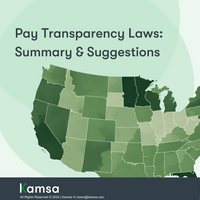
How to Customize Salary Ranges
Many things go into establishing a comprehensive compensation structure. It starts with obtaining market data, job leveling, and then determining a compensation philosophy. Further customizing salary ranges is a necessary exercise companies should go through to ensure their pay decisions align with the company’s strategy and drive employee performance.
For the salary ranges to be most effective during hiring and in compensation reviews, People (HR) and company leaders should evaluate and tailor the ranges to meet the company’s unique needs. Tailoring salary ranges means adjusting them as needed (i.e., adding premiums or discounts to account for the scope of responsibilities for each job, compared to the market).
This article provides tips on adjusting salary ranges, including examples of how companies can tailor their pay bands to meet their business and retention needs.
Types of Salary Range Adjustments
- Scope
- Internal Average
Scope Adjustments
When the scope of a role within your organization differs from the market, you may need to add a premium or discount to the salary range to better align with your business needs.
For example, one of Kamsa’s health tech clients has roles requiring premiums due to specialized skill sets. Their Financial Analyst role requires investment banking and/or clinical experience, which is challenging to find talent. This unique role's salary offer must be more competitive. Therefore, they used a 10% premium for Kamsa’s Financial Analyst job match.
Internal Average Adjustments
Staying internally equitable is vital in a transparent work culture; the internal average is a great data point to leverage (in addition to external market data) to evaluate your employees' pay fairness. Examining the internal salary data for a given job and assessing any pay gaps between new hires and current employees in the same position is important to consider when making job offers.
For example, Company A targets the 50th percentile for Sales roles, and they have Account Executives in the US. And let’s say the market midpoint for that role is $96,000 (see the below example). This company’s internal average (current employees in the Account Executive role) is $80,000, which is lower than the minimum of the range. To avoid pay disparity between existing employees and new hires, Company A should consider offering the minimum of the salary range for now ($81,500) and work on a plan to get all employees in this role more competitive over time.

Remember, to accurately calculate the internal average, you must perform job leveling for your entire organization. Job leveling ensures that employees align with the accurate market title/job level, making market comparisons more accurate.
Final Thoughts
The above are just a few examples of how you can tailor your salary ranges to meet your business needs. Establishing your salary ranges to ensure that it is not just internally equitable but also eternally competitive to the market is key to retaining employees while simultaneously meeting business needs. Before each compensation review, it’s essential to review if any adjustments to your salary ranges are still applicable.
About Kamsa
Kamsa provides market compensation data, job leveling, and compensation management solutions. Our market data, combined with consulting services, helps companies keep their employees’ compensation aligned with their business needs.


